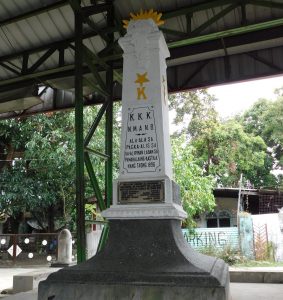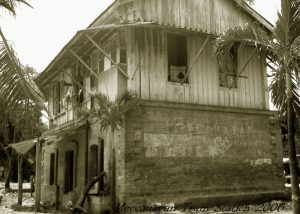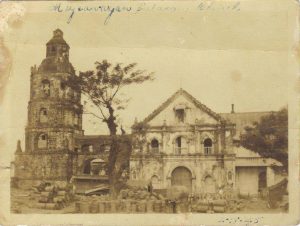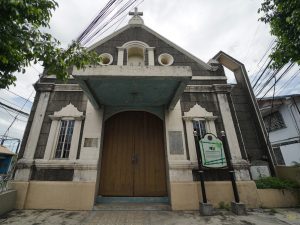BATTLE OF LANGKA MONUMENT
LANGKA, CITY OF MEYCAUAYAN, BULACAN

A monument builds to commemorate the bravery and patriotism of Meycaueños. December 17, 1896 General Diego de los Rios attacked the “Real” in barrio Langka, with the famous Regimiento 73.º (Infantería de “Joló”). The 1,500 armed men flocked the camp that was valiantly defended by Katipuneros led by Col. Ciriaco Contreras, a local hero of Meycauayan.
CROSS OF SITIO TORIL
Bahay Pare, City of Meycauayan, Bulacan

Considered as the oldest religious relic in the town of Meycauayan. It is crafted in the late Baroque style and is dated by Philippine church history expert Regalado Trota Jose at around the late 17th century. Although it may be the oldest church relic found in Meycauayan, it is doubtful that it came from the parish founders Diego de Oropesa and Juan Plasencia.
The cross was erected by Franciscans. It was re-discovered by three members of the St. Francis parish’s Committee on Church Cultural Heritage in the year 2001. The cross was in the custody of the late Fidel Amparo of Barangay Bahay Pare, whose house is near the site of what is believed to be the original site of the first parish church and/or the first town center. Upon his death, the cross has been turned over to the barrio chapel. The cross is loaned every year to the parish church of St. Francis of Assisi on its feast day of October 4.
ESTACION FERROCARRIL DE MEYCAUAYAN
Malhacan, City of Meycauayan, Bulacan

The Meycauayan Old Train Station was a part of the Manila-Dagupan Railroad, the first rail line in the country. The construction of the started at 1887 and was finished at 1892. The Meycauayan Station served as headquarters for the Philippine Revolutionary Army where Gen. Antonio Luna posted on its door his “Scorched Earth Policy” (Articulo Uno). The station was used by the Americans as their headquarters during the Phil-American War and a Japanese garrison during WW2. This Old Train Station serves as a mute witness of all our journeys as people, brave but loving Meycaueños.
PARISH OF SAINT FRANCIS OF ASSISI CHURCH COMPLEX
Poblacion, City of Meycauayan, Bulacan

The first church was destroyed by a typhoon in 1588 and the town proper was moved to Lagolo. The construction of the present church was started shortly after its transfer to the present site in 1668. Fray Francisco Gascueña, O.F.M., who builds the belfry in 1800, preached the gospel in China for six years, and on being exiled from that kingdom out of opposition to his religious teachings returned to Meycauayan. He served this parish for 31 years and died here on November 18, 1831. The convent was built from 1731 to 1759. It also served as Escuela Parroquial and became headquarters of the Revolutionary government in 1898, where the Philippine Flag was first raised in the town. The First election in Meycauayan was held in the church convent by Major William A. Kobbe.
The church was destroyed by a massive fire in April 4, 1949, known as the Great Fire of Meycauayan. Artefacts such as old memorabilia are some of the casualties of the fire and the retablo built by Fray Benito de Madridejos in 1854 was destroyed. Only a few church items including the tabernacle were saved from the fire. Together with other collected artefacts, it is now housed in the Museo Parrochial de Meycauayan established in 2014.
After its destruction, reconstruction of present structure soon follows and further developments were added. Attempts to bring back its old glory was always there, however legit church’s restoration effort was only done in 2020 where the church interior was restored and the Old retablo was reconstructed.
OLD LAGOLO CHURCH
Malhacan, City of Meycauayan, Bulacan

A request was made to build a stone church, and on November 16, 1588, Dr. Santiago de Vera, made justified by such request, instantly dispatched Secretary Gaspar de Azebo to Christoval de Asqueta, Alcade Mayor of Meycauayan. By the order of Fray Pedro Bautista (Now Saint) Ministro Provincial of the Franciscans, it was transferred to a place called Lagolo, by Fray Antonio de Nombela, Minister of the town. In 1589, by the decree of the Superior Govierno, a church made up mainly of adobe (volcanic tuff) was built. The said church was the place of worship of Meycaueños until 1668.
